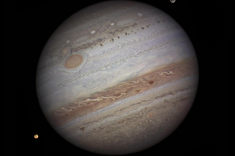
Solar storms are triggering X-ray auroras on Jupiter that are about eight times brighter than normal over a large area of the planet and hundreds of times more energetic than Earth’s “northern lights.”
Credit: NASA/CXC/UCL/W.Dunn et al, Optical: NASA/STScI
Jupiter’s already impressive auroral displays get a big boost from solar storms, a new study reveals.
Jupiter’s auroras blazed eight times more brightly than normal in X-ray light in response to an October 2011 sun storm, generating hundreds of times more energy than Earth’s famous northern lights . The finding could help scientists better understand a wide range of cosmic objects and phenomena, study team members said.
Lead author William Dunn, a doctoral candidate at University College London’s Mullard Space Science Laboratory, and his team used NASA’s Chandra X-ray Observatory to study how Jupiter’s auroras behaved in the aftermath of an October 2011 coronal mass ejection (CME). CMEs are eruptions that send clouds of superhot solar plasma streaking through space at millions of miles per hour.
CMEs also ramp up the solar wind, the stream of charged particles that flow constantly from the sun. A CME-boosted solar wind can compress the boundaries of Jupiter’s magnetosphere — the region of space dominated by the giant planet’s powerful magnetic field — by 1.25 million miles (2 million km) or so, researchers said.
The new study determined that solar wind-magnetosphere interactions at this shifting boundary after the 2011 storm sparked the high-energy X-ray emissions in Jupiter’s auroras — a finding that could have applications here on Earth and much farther afield, researchers said.
“Comparing new findings from Jupiter with what is already known for Earth will help explain how space weather is driven by the solar wind interacting with Earth’s magnetosphere,” Graziella Branduardi-Raymont, an astrophysicist at the Mullard Space Science Laboratory, said in a statement .
“New insights into how Jupiter’s atmosphere is influenced by the sun will help us characterize the atmospheres of exoplanets, giving us clues about whether a planet is likely to support life as we know it,” Branduardi-Raymont added.

0 of 10 questions complete
A clearer picture of the relationship between the sun and Jupiter’s magnetosphere should be coming soon. NASA’s Juno spacecraft is scheduled to arrive in orbit around Jupiter on July 4, and shortly thereafter will begin studying the giant planet’s magnetic field and auroras, among other things.
The new study was published Tuesday (March 22) in the Journal of Geophysical Research – Space Physics.
Follow Mike Wall on Twitter @michaeldwall and Google+ . Follow us @Spacedotcom , Facebook or Google+ . Originally published on Space.com .

Comments are closed.